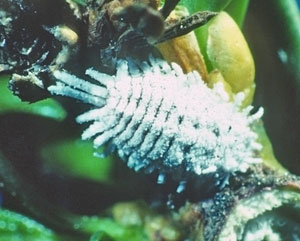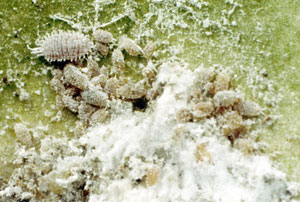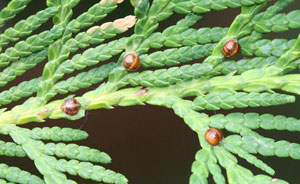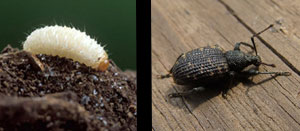Sap Feeders

John A. Davidson, Univ. Md, College Pk, Bugwood.org
The most noticeable stage of the Taxus mealybug is the adult female, which is about 2/5 inch long and is red but is covered in white "fluff" with long filaments projecting from the sides and back. They overwinter as nymphs in the bark before resuming feeding in the spring. By early summer they have become reproductive adults. There can be 1-3 generations depending on the state. They tend to be located in the interior of the plant, around branch crotches. They can be difficult to locate because of this. Symptoms of an infestation include leaf loss, chlorotic looking branches, dieback, and honeydew/black sooty mold issues.
Taxus bud mites are small mites that can induce damage and even death of buds. Occasionally their feeding will cause distortion to needles and shoots. The adults overwinter between bud scales, with peak damage occurring in the late summer and early fall.

Clemson University - USDA Cooperative Extension Slide Series, Bugwood.org
Comstock mealybugs are small, oval, waxy pests that feed on the sap of plants. Adult females are 3/16 inch long; the body is a brownish color but is coated with a white wax. They produce honeydew as fecal material which can also encourage the growth of black sooty mold on the plant. There are two generations per year, with overwintering eggs hatching in the spring. Spring nymphs feed and mature by July. They mate and then produce another generation that matures by September.

Steven Katovich, Bugwood.org
Adult Fletcher scale females are globular soft scales with a yellow to brown coloration; males become winged reproductives. Immature scales are flatter but swell as they develop. As they feed they can cause tree decline and produce large amounts of honeydew, which can attract other insects and black sooty mold. They overwinter on branches as second instar nymphs and mature the next spring by May. Eggs produced in Spring hatch by June or July.
Root Feeders

grub: Peggy Greb, USDA Agricultural Research Service, Bugwood.org ;
adult: Cheryl Moorehead, Bugwood.org
Black vine weevil grubs are white legless larvae with yellow brown or red heads that live in the soil and feed on plant roots. They are a serious pest of yew. Moderate root feeding may cause plants to show signs of drought stress, but serious root injury and girdling can occur, occasionally leading to death of the plant. The adults (0.5 inch long) are dark snout beetles that may chew crescent-shaped holes in leaves while feeding at night. Normally there is one generation per year with the larva overwintering. Pupation and adult emergence occurs in the spring. Sometimes adults may overwinter which can result in damage occurring from larvae earlier in the season.